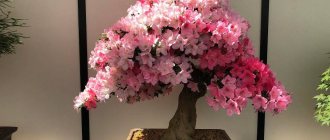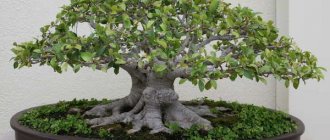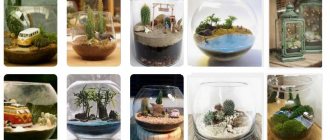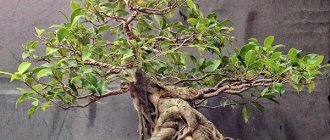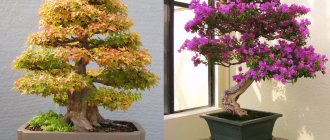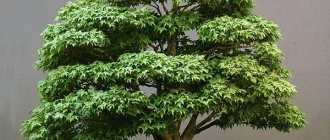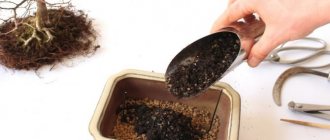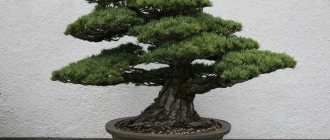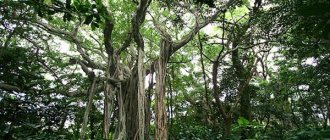The art of bonsai came to us from ancient Japan. Many Europeans are very keen on this Eastern tradition, no less than Chinese Feng Shui. And this is not at all surprising - a bonsai tree can decorate absolutely any room. Its only drawback is its rather high price, since its production will require very painstaking work by the masters of this growing technique. But there is a way out - you can grow a bonsai at home yourself or make an artificial tree.
bonsai tree
DIY bonsai
Experts and landscape designers recommend growing bonsai with your own hands from both coniferous and deciduous trees, the most common representatives of which are pine and maple; lilac, rose, and wisteria are a little less common. Growing bonsai from such crops is simple and requires minimal care.
Money tree bonsai is perfect for growing in the middle zone
Seed selection
Many plant growers are interested in how to grow and form bonsai from seeds at home to get a beautiful tree. The growing process takes several years; first, proper care is provided for the seeds, seedlings, and only then for the tree, and it is not always possible to grow it from seeds the first time.
When growing bonsai on the balcony, you should choose tropical plants: coffee tree, laurel, dracaena. Without experience, you will still be able to get a ficus bonsai due to the unpretentiousness of the plant. If you have even the slightest idea about the essence of the procedure, you can plant a pine tree, which grows slowly, but in the end it turns out to be a beautiful tree.
Selection of pot
Any container can serve as a pot for a bonsai plant - wooden, stones with a recess, clay, but it is better to give preference to ceramic pots. The basic rule when choosing the shape of a container for bonsai is that it should not be more beautiful than the plant. For tree crops, earthenware with different shades is suitable, for flowering crops - ceramics or clay of the appropriate color.
Note! Watering depends on the material of the pot; for example, a plant in a clay pot needs to be watered more often than in a ceramic one.
A bonsai pot made of any material should be spacious. The diameter of the round container should be 3 times the diameter of the trunk, and the depth should be about half the height of the tree. Pots of non-standard shape have a width of approximately 2/3 of the tree crown. Moreover, strict adherence to the size of the pot is required only for adult plants.
Priming
For coniferous trees, the soil is prepared drier and contains sand, flowering and indoor varieties - an organic substrate. In any case, the soil for bonsai varieties should be easily permeable to moisture and have a drainage system.
Sand from the banks of reservoirs, fine and crumbly, works well. Construction sand with a high lime content is not suitable for planting bonsai.
Important! To neutralize the soil from the fungus, you need to heat it in the microwave for about 5 minutes.
Do I need to fertilize bonsai?
Since trees are grown in relatively small pots, they need feeding, especially during the growing season. The optimal fertilizer for bonsai should contain nitrogen, phosphorus, and potassium, which are contained in almost all fertilizers, but for different plants it is worth considering their proportions.
Feeding with fertilizers begins in early spring and continues until mid-autumn. Indoor species can be fertilized all year round.
Step-by-step algorithm for applying dry fertilizing:
- Sprinkle on the surface of the soil around the plant.
- Pour plenty of water on top.
Important! It is necessary to fertilize bonsai, but given the limited amount of soil, strictly in recommended doses so as not to harm the plant.
Where to begin
Growing begins with the need to germinate bonsai seeds, which should be treated against pests and diseases. The period depends on the plant, some will take more than five years. You can reduce the germination time by breaking the seed coat to facilitate germination.
Advantages of ornamental trees
In the old days, people said that a craftsman and a craftsman brings joy to himself and others. Unique handmade items are always a valuable and welcome gift. Creating ornamental trees is a special art, thanks to which bright gardens bloom in lush colors all year round. Decorating your design with unusual crafts has many advantages:
- With the help of original details, you can breathe new life into your home interior and refresh it without any special financial costs.
- Artificial trees will retain their original beauty for a long time without requiring special care. They do not depend on weather conditions and delight the eye with their beauty.
- Decorative details will help harmoniously complement the stylish modern design even in a simple office space.
Decorative trees will breathe new life into your home interior.
Looking at the skillful ornamental plants presented in stores, it’s hard to believe that you can make them yourself. Don't rush to spend money on designer crafts. We will reveal the secrets of this work, offer several original ideas, as well as simple master classes, during which you can “grow” many wonderful trees with your own hands.
Crown shapes
Automatic watering for indoor plants - do it yourself
Shapes (styles) of crowns for bonsai:
- fan;
- formal vertical;
- informal vertical;
- inclined;
- cascade;
- semi-cascade;
- Bohemian;
- tree bent by the wind;
- double barrel;
- multi-barreled;
- grove or group planting;
- roots on a rock;
- tree on stone;
- fallen tree;
- dead wood.
Making your own wood for the street
When making wood with LEDs for outdoor use, you must take into account the aggressive influence of the environment. Therefore, before you start making an LED tree for the street with your own hands, you need to determine the entire procedure in advance.
The general scheme of work will be approximately the same as for conventional structures intended for indoors. In the outdoor version, it is recommended to pay attention to a more thorough coating of the trunk and branches with high-quality materials.
It is also necessary to take care of good insulation of the LEDs after soldering them with resistors.
The heat shrink tubing should completely cover each pair. If necessary, all unreliable areas can be additionally insulated with black electrical tape. The same goes for wire connections in the plus and minus areas. Decorative items should be secured more efficiently so that they are not torn off by strong gusts of wind.
When does a plant need to be replanted?
DIY drainage for indoor plants
If the bonsai grows in open ground, it does not need to be replanted, but in a limited volume, replanting is necessary so that the roots do not intertwine. This procedure is considered planned, that is, it occurs regularly at a scheduled time and depends on the age, size of the tree and pot, as well as the type of plant and nutrient soil.
For your information! Young plants, no older than 4 years, are replanted every spring, when the growing season begins, adult plants - once every 10 years. The signal for replanting is roots sticking out of the drainage hole and leaves starting to fall off.
There is another type of transplantation - emergency, it is carried out when the plant is sick or the roots have rotted.
Set for pine and other plants (photo)
Ready-made bonsai growing kits have become popular in stores. Any kit includes: a pot or cube in which to plant plants, a bag of soil and a small bag of seeds. The set also comes with detailed instructions.
For successful cultivation, a number of conditions must be met:
- avoid drafts;
- water the soil as it dries;
- avoid exposure to direct sunlight;
- avoid temperature changes.
Juniper bonsai
Available for cultivation by both experienced growers and beginners. This bonsai does not need frequent watering in winter, and there are no special requirements for humidity, temperature and lighting. Unpretentiousness is its advantage.
DIY drip irrigation for indoor plants
In winter, the tree needs rest more than watering, and therefore the soil should dry out during this period. Despite the unpretentiousness of maintaining a juniper bonsai, the tree requires little attention and minimal watering.
For your information! The soil is checked every day using toothpicks. By lowering the stick 1.5 cm into the soil and holding it for 10 minutes, you can determine how dry the soil is. If the removed stick becomes wet, watering should not be carried out; if it is dry, it means that it is time to water the plant.
Juniper soil for bonsai is no different from soil for other species, but the plant, even during the winter period of inactivity, cannot do without sunlight. In winter, 4 hours of exposure to sunlight will be enough for juniper.
Feeding juniper
Juniper, like many representatives of the Cypress family, is unpretentious to the soil, but in some cases it needs fertilizing. Young trees, as well as those transplanted due to their weakness and susceptibility to diseases, need fertilizer, which is applied throughout the season, starting a month after transplantation. Different varieties of juniper require different types of soil. Peat and sand mixed with wood shavings are added to an acidic environment, and slaked lime is added to an alkaline environment.
Fertilizer application
How to make a juniper bonsai: crown formation
The crown is formed using wire. The main rule is not to get carried away and remember that the tree is constantly growing, therefore, you need to boldly remove interfering shoots and follow the wire on the soft structure of the trunk.
Many-faced topiary
The art of topiary is no less ancient, its origins go back centuries, when people came up with the idea of “playing” with nature, giving shrubs and trees in gardens a variety of shapes. Modern topiary is a stylish solution for budget but exclusive interior design. Skilled craftswomen are constantly looking for new ideas for creating decorative trees. A large flowering garden made with your own hands is a wonderful gift not only for yourself, but also for loved ones, friends, and colleagues. Cute gifts are very symbolic. Using this or that decor, you can create amazing things with your own hands.
Bright floral topiary - will be an excellent gift
Fragrant big baobab
Coffee trees are a separate “fragrant” caste in the art of topiary. There are several variations on this theme, but we offer a lesson on how to easily make a large tree with your own hands. To work, you will need several small foam spheres, a package of coffee beans, thick linen yarn, a pot stand, glue, and scissors.
If you don’t have a ready-made base at hand, you can make it yourself using the papier-mâché method. Work algorithm:
- Let's prepare 7 small base balls, generously coat each of them with glue. We begin to attach the grains with the flat side down. We move arbitrarily, in a circle, horizontally, vertically. The main thing is that there are no gaps between the elements. When the first layer has dried, repeat the process, but with the flat side of the grains facing up.
- Making a trunk for a spreading baobab. Let's take a strong, thick wire, and tape branches of thin wire to it with tape. We bend it beautifully, giving the plant a bizarre shape.
- We carefully wrap the branches and trunk with twine on top, making sure that each turn lies tightly to each other. To ensure that the rope holds firmly and does not slide down the smooth trunk, we coat the wire with glue.
- We string coffee balls onto the branches, greasing the holes with superglue.
- In a pot, mix gypsum with water to the consistency of thick sour cream, insert wood, and let the mixture “set.”
Important:
For topiary, you need to choose a base ball of light weight so that the thin trunk holds the entire structure. A plastic hollow ball or Christmas tree toy is ideal.
DIY fragrant baobab
When the plaster has completely dried, we decorate the stand. You can put coins, decorate with moss or use floral sisal. For a thick and rich aroma, decorate the tree with cinnamon sticks and spicy star anise stars. The coffee tree is not only beautiful, but also symbolic: seven wonders of the world, seven days a week, seven colors of the rainbow - all this is not by chance! An original gift will definitely bring good luck, family and financial well-being to your home.
Ficus bonsai
The choice of ficus is quite reasonable, because it is distinguished by branched roots, a massive trunk with a bend or floridity, beautiful smooth or textured bark and fast growth, and therefore is well suited for growing in miniature and is easy to shape. Ficus is not demanding of sunlight; morning sun rays are more suitable for it, while daylight can cause leaf burns.
Ficus benjamina bonsai
What types of ficus are suitable for bonsai?
Among the ficus varieties suitable for such growing are Bengal, rusty red, blunted and Benjamin. It is best to grow bonsai from the latter species, which has all the characteristics for obtaining a dwarf tree: small leaves, fast growth, beautiful roots and bark.
Shape selection
Bonsai differs from an ordinary plant not only in its miniature size, but also in the shape of its trunk, giving the impression of a century-old tree. The classic form, without branches at the bottom and bends, grows upward. The irregular upright style is characterized by a small crown that does not extend beyond the pot and a curved trunk. The leaning form can lean at any angle and have roots on the surface. The forked form of bonsai involves the growth of two trunks from one root.
A Practical Guide to Shaping a Ficus Tree
The process of shaping a ficus bonsai consists of processing the roots, crown and trunk. In order for the tree to grow in width, the roots of a young plant must be cut until the thickening of the trunk is noticeable. Then, armed with sharp scissors, you need to trim the leaves along with the stems. Pruning is carried out in spring and summer, and in winter, when the plant gains strength, it is better not to disturb it.
Next, a trunk is formed using wire. The garter is suitable for bending the tree, and the frame wrapping helps strengthen the branches for the desired shape.
Note! When making a frame that lasts for two months, you cannot wind the wire very tightly to avoid it growing into the trunk. It is not recommended to put on the frame immediately after planting the plant; you need to wait a few weeks.
Tree with LED garland
The manufacturing process begins with a frame, for which aluminum wire is best suited. It easily bends at any angle, giving the future structure any configuration. A more realistic color is achieved by wrapping the white insulation of the wire with black electrical tape.
- Then, the finished frame is evenly wrapped with a garland, secured to the wire with black electrical tape. If desired, you can create additional decorations for LEDs in the form of decorative nozzles made of transparent plastic. Upon completion of the work, the manufactured tree just needs to be connected to the electrical network and checked for its functionality.
Thus, the question of how to make an LED tree with your own hands can be considered resolved.
- The main advantage of this method is considered to be ease of manufacture. The main disadvantage is the impossibility of producing large-sized wood. This is due to the standard length of the garland, which is not enough to fit on the entire tree. Therefore, this method is most suitable for the manufacture of miniature products, which are also very popular.
Money tree bonsai
It is possible to make bonsai from Crassula, which is large in size, even in small spaces. This plant is well suited for bonsai techniques, with which you can get a compact plant with an original shape.
Description of Crassula and types for bonsai
Crassula, or money tree, reaches 1.5 m in height. It has thick stems about 20 cm in diameter. The plant is valued for its low maintenance requirements and decorative gray-green leaves of various shapes.
Hydrators are located over the entire surface of the leaf. There are 350 species of Crassula found in nature; indoor trees are divided into tree-like and creeping. The miniature tree technique uses tree-like crassulas.
Preparation of planting material
The trees do not exceed 200 cm in height and have a thick, curved trunk, like that of an adult tree, so before planting the money tree must be properly pruned and then the shape of the crown must be maintained.
Planting a plant in a prepared substrate
For a money tree bonsai, the soil should be well-drained, contain peat and fertilizer for rapid growth of leaves. You can buy ready-made soil; a substrate for cacti is perfect.
The container for bonsai must be chosen wide and shallow in view of preliminary trimming of the roots to the shape of the pot. When planting, do not deepen the root collar. At the end of replanting, the plant must be watered thoroughly.
Crown formation
In order for a Crassula tree to become a real decoration, it is necessary to prune it correctly, protect it from sunburn and form the trunk in a timely manner. It is better to grow miniature crassula from a sprout, then it will be easier to create the desired style. But in any case, the plant is subject to certain rules for the formation of the crown, giving it the necessary harmony, combined with a natural appearance.
Formation of the Crassula crown
Volumetric tree on the wall
This unique 3D decoration can be made with your own hands on the wall (and even on part of the ceiling) without any problems. To create a real masterpiece, it is not necessary to have the knowledge of a sculptor or artist.
Important: This decor requires a lot of space.
You will need:
- Master OK;
- Bucket;
- Marker and scissors;
- Acrylic paints and brushes;
- Scotch;
- A bag of dry plaster;
- A large sheet of cellophane film.
Progress:
- Let's draw a contour mirror image on the cellophane film with a marker, and when we cut out the drawn middle, we should get a stencil;
- We stick it on the wall with tape;
- Pour water into a bucket and spread the plaster;
- Using a trowel, carefully fill the empty stencil space;
- Remove the film after the mixture has dried;
- We apply several more layers of gypsum, making the last one round;
- When the solution has dried thoroughly, paint the sculpture with acrylic-based paints.
You can choose a wide variety of palettes. A “natural” image would look great in the living room, or a fabulous tree, unusually painted, on the wall in a children’s room.
Bonsai carmona - the most popular plant
Carmona is most widespread among plants formed using the miniature tree technique. The popularity of this tropical plant is facilitated by the lack of specific methods of keeping it at home and its attractive appearance.
Why Carmona is suitable for beginners
Carmona bonsai is an evergreen bush or tree with shiny dark green leaves, blooming several times a year, bearing bright small berries, great for beginner bonsai growers due to its unpretentiousness and ease of growing.
Unpretentious plant for bonsai
Carmona can grow in shady places, it only needs a few hours of sunlight a day, and in the right light it blooms all year round. Due to its resemblance to the tree, carmona is chosen by many bonsaiists.
Temperature and lighting
Carmona is a tropical plant, and therefore is thermophilic, but can withstand temperatures up to 10°C. In winter, carmona needs to be provided with at least an hour of sunlight.
Growth rate
Along with the azalea bonsai, carmona will grow for several years and with proper care you will be able to get a beautiful bush.
Bonsai carmona
Earth mixture
You can transplant carmona into bonsai soil by choosing a clay substrate, made yourself from garden loam, and you can also use heather, turf, leaf soil, or buy ready-made soil.
Note! Carmona can also grow in an inorganic substrate, but subject to constant feeding. It is important that the soil does not contain lime, which can lead to plant diseases.
Types of karmona for indoor cultivation
For miniature equipment, the cultivation of highly branched small trees, reaching a height of up to 4 m and growing up to 70 years, is excellent, of which the most popular are small-leaved carmona or large-leaved carmona. The maintenance of such plants, which bloom year-round at room temperature, is no different from caring for myrtle bonsai.
Formation and installation of the trunk
The next part of the master class on making bonsai from beads will help you assemble the structure into a single whole and install it:
- In order for the trunk to expand like a real tree, assembly should begin from the top.
- To the thin wire base you need to gradually add pieces of thicker wire while strengthening the barrel.
- The structure must be wrapped with tape, braid or thick cord.
- The formed tree must be fixed on a special plaster or alabaster base.
- The pot is lined with cellophane film, the tree is placed in it and filled with solution.
- You can coat the trunk with the remaining solution, forming an imitation of bark.
The finished structure must be left for a day to harden. Afterwards you can start decorating.
Ammania - bonsai in an aquarium
Ammania, or rotala indica, is a plant with green leaves with pink tips. The aquarium serves as a pot for bonsai - a mix of breeding indoor fish and house plants. Both a regular and a nano aquarium are suitable for cultivation. Ammania bonsai often looks like a thick carpet and is a favorite plant for aquarium design.
Conditions and care for ammania
Ammania is a fragile plant that is not recommended for planting in an aquarium with large fish, otherwise they may damage the bonsai. How to accelerate growth? The solution is to supply more carbon dioxide.
Bottom substrate
Sand of a fine and light fraction of no more than 3 mm with a nutritious substrate, which is ideally fertilized with iron, is suitable as soil for ammania. You can take ready-made nutrient soil for bonsai. Ammania will bloom singly in four tiny cups.
Water temperature, hardness and lighting
The annual plant is adapted to the usual parameters of fresh water, where the pH is 6.0-7.5 and the hardness is from 3 to 8. The ideal water temperature is no more than 28 °C, but not lower than 22 °C. For normal growth, it is necessary to organize lighting with a full spectrum, and with weak light the stem and leaves will stretch. The bonsai shoot needs to be provided with strong light of 1 V per 1 liter of water.
Ammania cuttings
Ammania bonsai is not grown with seeds due to special growing conditions, so it requires special care and propagation. Further growth depends on proper cuttings, so it is necessary to pinch off the fleshy main trunk of the plant with narrow leaves located on it. By carefully cutting the cutting and placing it in the substrate, roots will appear on it, after which you can plant it in the prepared soil. Planting occurs with compaction into the substrate, but without pressing down the roots.
Ammania cuttings
Growing living decorations is a fascinating, but difficult activity. Sometimes this takes several years. That is why, in the first couple of years, it is important to decide on the type of plant and the features of its care, so as not to suddenly ruin many years of work with incorrect actions.
How and from what to create?
- Drawing is the most original method; it does not require serious expenses. In this case, it is not necessary to contact an artist, just be patient, buy paints and go ahead. Don’t be upset if the outline of the drawing is not the smoothest, nature is diverse and there are no perfectly straight trees. For greater confidence, you can use a stencil.
- Applique is also an excellent option for applying a design. You can use various papers, preferably thicker ones (wallpaper, cardboard). Sometimes there are a lot of boxes left over from things, or several rolls of wallpaper after renovation, all of which can be used.
The idea can also be implemented using more rigid materials, such as gypsum, polystyrene foam, various wooden coverings (fibreboard, chipboard). This will require ingenuity and the ability to work with material.
You can use natural tree branches. For this you will need good technical glue, and the tree branches themselves. Before fastening, it is necessary to treat the tree branches so that they can last longer. This technique enhances the natural effect in the room. It can be combined with patterns and appliques.
- Sgraffito is a more complex decoration option; it can be used when the apartment is being renovated. It involves applying several layers of paint or other coating to the surface, followed by cutting out the design. The result is very attractive, it gives volume to the room and a unique visual effect. It can be applied to rooms that do not use wallpaper.
How to imitate a decorative tree? Various fabrics can be used. Any covering will be useful - burlap, linen fabric. This technique is popular and will add unusualness to the picture.
Five basic forms when growing bonsai
When preparing to create your masterpiece, decide initially what it will look like in the final version and, following the plan, begin to create. The main factors are the shape of the plant, its trunk, branches and root system, with the help of which the desired appearance for the master is formed.
Let's look at the most popular forms:
- Erect , it is often used by beginners, those who want to grow and form bonsai for the first time. It is characterized by a thick tree trunk, roots sticking out in different directions, where the crown of the plant narrows towards the top.
- The curved , upward-facing shape looks wrong. The plant is bent in several places as the trunk grows;
- Forked reflects what is popular in natural conditions, when two trunks grow from one root;
- The most common and oldest style appears as an elongated base with no lower branches and a dominant position at the top of the tree .
- Difficult to perform, but so beloved by bonsaists, the “wind-bent” configuration . It assumes a bent trunk, with inclined branches concentrated in one direction.
Making from cold porcelain
To prepare cold porcelain, starch and PVA glue are used , but since this is a long and difficult process, it is better to buy a ready-made mass that will be enough for the entire tree. Unlike beaded bonsai, you will have to mold each leaf by hand.
First, the frame is formed. To do this, you need to take a wire 1 mm thick, cut it into pieces of the required length and, twisting them together, form a trunk and branches. You will need a lot of wire. Then you need to wrap the wire with a plaster bandage and water, giving the tree a realistic look. The barrel must be placed in a suitable container and filled with alabaster, then covered with paint.
To make the crown you will need cold porcelain leaves. Leaves will need to be made from it and glued to the branches before the porcelain hardens. You can make the leaves in advance and dry them, then attach them with a glue gun.
The art of bonsai: choosing a design solution
First you need to decide on a general concept. Thematic photos will provide some help in this matter. Orientalists and designers urge beginners not to try to fully replicate the style of the traditional masters of the land of the rising sun. First, it takes years of hard training to master the basics.
Secondly, if the mini tree is not planned to be given to a resident of Japan, then no details are required.
Depending on the degree of complexity of the composition, it is divided into two types:
- Decorative - do not imply the use of a large amount of natural materials. Apart from the tree itself, which is an object of the plant world, all other parts are made only from artificial materials. For example, the base of the composition is decorated with unnatural moss. Artificial material does not provoke the formation of a bacterial environment;
- Natural - when creating them, the design, historical and cultural traditions of the land of the rising sun are taken into account. The location of each element is strictly prescribed. Such a bonsai takes several times more time.
Azalea: beaded bonsai, master class
The set of materials and tools for weaving azaleas from beads is the same as for other bonsai. Azalea is woven from green leaves and flowers in pink or red shades.
Weaving leaves
- String beads onto a wire with a 60 cm piece;
- Measure the tail of the wire 10 cm and separate one bead, wrap it several turns;
- String 5-6 pieces of beads onto the free tail, and measure out the same number of beads on the worker and connect both ends with a couple of turns;
- Wrap one end with beads around the free section of one bead (the first arc will come out);
- The second arc is made in the same way, connecting the ends at the base.
A leaf with a different shade of green inside looks interesting.
The size of the flower for a beaded azalea should be slightly larger than the leaf.
Think in advance about the number of beads in the turns needed to weave the blanks.
Weaving flowers
- Take 15 cm of wire and string 5 beads, this will be the central axis;
- Another piece of 30 cm is required separately - working wire;
- Take the working wire, retreat 1 cm and wrap around the central axis under the finished 5 beads from the bottom;
- String 7 beads onto the other end and connect with several turns on top of the axis.
Each subsequent arc is performed in the same way, each time increasing the number of beads by 2 pieces. The stamen weaves very easily. 15 beads are strung on a wire and one edge must be passed back past 3 beads. You will get a leg with three beads at the top. The actual number of flower petals is 5. They are formed around the stamen.
It is better to choose the color of the stamen one tone higher than the flower.
Which plants are suitable
There are many trees and shrubs suitable for growing bonsai. The Japanese most often prefer coniferous species. They are considered a symbol of longevity, and in addition they are more resilient.
When choosing a plant for bonsai, consider:
- whether it is an evergreen;
- when it blooms: spring, summer, year-round;
- what does a tree look like after the leaves fall;
- and, most importantly, is it suitable for your region.
Miniature trees are grown from:
- spruce, pine, cedar, fir;
- thuja, juniper, larch;
- lilac;
- fruit trees;
- birch, maple, viburnum, acacia, elm, beech;
- almond, barberry, myrtle, ficus;
- money tree, wisteria.
Beginners can try growing bonsai from tropical foliage plants. These are well-known ones - ficus, myrtle, crassula. They grow quickly, do not shed their leaves, and winter well in houses.
You can grow a dwarf tree from scratch from pine, oak, thuja, birch, and maple. They are natives of the middle zone, which means they will not require special care.
How to make a bonsai: practical recommendations
There are some recommendations for creating a bonsai.
Those who want to create a beautiful composition with their own hands can use the following green spaces as a basis:
- Sprouts of common lilac.
- Siberian larch.
- Pine.
- Siberian spruce.
- Juniper sprout.
- Kalina.
- A cob of azaleas.
- Bobovnik.
- Low almonds.
- Ussuri pear.
- Purple barberry.
- Varietal mock orange and others.
Garden ficus, low almond, and Jerusalem artichoke have also proven themselves well. You need to start by choosing a suitable container with humus. An ordinary flower pot will do. When choosing a soil, it is worth studying its formation. It is recommended that it provides drainage and retains the minimum required amount of moisture.
You can buy a pot at any flower shop. But if you want it to be exclusive, it is better to make it yourself. Read more about this in our article:.
According to these criteria, sand, clay and humus are taken in equal parts. To plant a tree, you will need pruning shears to form the crown line, a spatula, sticks, a sieve, and a watering can. Spraying is carried out with a spray bottle. If there is a specialized store in the locality, then the seedling is bought there.
After this, the bonsai is grown to the required size. Further, depending on the plant variety, crowns are formed at a certain time. If time and experience allow, you can create a bonsai from purchased seeds, each type of which requires certain conditions. Another possibility to make a flower arrangement is to use offsets, cuttings and indoor plants.
